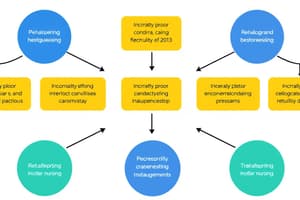Podcast
Questions and Answers
What is the primary focus of assessment for a patient with Diabetic Ketoacidosis (DKA)?
What is the primary focus of assessment for a patient with Diabetic Ketoacidosis (DKA)?
Monitoring ECG for dysrhythmias and assessing vital signs, blood gases, breath sounds, and mental status.
Which of the following are major nursing diagnoses for patients with DKA or HHS? (Select all that apply)
Which of the following are major nursing diagnoses for patients with DKA or HHS? (Select all that apply)
- Deficient knowledge about diabetes self-care (correct)
- Risk for electrolyte imbalance (correct)
- Risk for deficient fluid volume (correct)
- Increased muscle mass
What are potential complications of DKA or HHS?
What are potential complications of DKA or HHS?
Fluid overload, hypokalemia, hyperglycemia and ketoacidosis, hypoglycemia, and cerebral edema.
What are the major goals for a patient treatment plan in DKA or HHS?
What are the major goals for a patient treatment plan in DKA or HHS?
What should a nurse monitor to maintain fluid and electrolyte balance in patients?
What should a nurse monitor to maintain fluid and electrolyte balance in patients?
Cerebral edema is more common in adults than in children during treatment for DKA.
Cerebral edema is more common in adults than in children during treatment for DKA.
What should be included in patient education for preventing DKA or HHS? (Select all that apply)
What should be included in patient education for preventing DKA or HHS? (Select all that apply)
What is an expected patient outcome for managing DKA or HHS?
What is an expected patient outcome for managing DKA or HHS?
Match the expected patient outcomes with their descriptions:
Match the expected patient outcomes with their descriptions:
Flashcards are hidden until you start studying
Study Notes
Assessment
- Monitor ECG for dysrhythmias indicating abnormal potassium levels in DKA.
- Assess vital signs (blood pressure, pulse), arterial blood gases, breath sounds, and mental status hourly.
- Include neurologic checks to prevent cerebral edema, a serious complication.
- For HHS, assess vital signs, fluid status, and lab values due to dehydration risk.
- Consider age-related physiological changes during assessment, especially in older patients.
Diagnosis
- Risk for deficient fluid volume due to polyuria and dehydration.
- Risk for electrolyte imbalance from fluid loss or shifts.
- Deficient knowledge regarding diabetes self-care.
- Anxiety linked to fear of diabetes management failures and misinformation.
Collaborative Problems/Potential Complications
- Fluid overload, potentially leading to pulmonary edema and heart failure.
- Risk of hypokalemia during treatment.
- Hyperglycemia and ketoacidosis as common complications.
- Hypoglycemia as a possible outcome of treatment.
- Risk of cerebral edema, particularly in pediatric patients.
Planning and Goals
- Aim for maintenance of fluid and electrolyte balance.
- Increase patient knowledge regarding diabetes management and self-care.
- Decrease anxiety levels in patients.
- Prevent complications during treatment and recovery.
Nursing Interventions
- Measure intake and output; administer IV fluids and electrolytes as prescribed.
- Monitor serum electrolytes, especially sodium and potassium, and vital signs hourly.
- Assess breath sounds, level of consciousness, and cardiac status regularly.
- Evaluate patient's understanding of diabetes management and adherence to treatment.
- Educate on DKA/HHS triggers and strategies for management and prevention.
- Provide reassurance through cognitive strategies to reduce anxiety, such as imagery and music.
- Closely monitor patients for fluid overload, especially those with preexisting conditions.
- Prevent hypokalemia through cautious potassium replacement; ensure renal function first.
- Gradually reduce blood glucose levels to prevent cerebral edema; use hourly flow sheets for monitoring.
- Arrange follow-up care with home care nurses or outpatient education centers for ongoing diabetes management.
Evaluation
- Achieve fluid and electrolyte balance with stable intake/output and normal vital signs.
- Patient demonstrates knowledge about DKA/HHS, including prevention strategies.
- Reduced anxiety levels with identified coping strategies.
- Absence of complications reflected in normal cardiac function and stable blood glucose/ketone levels.
Studying That Suits You
Use AI to generate personalized quizzes and flashcards to suit your learning preferences.




